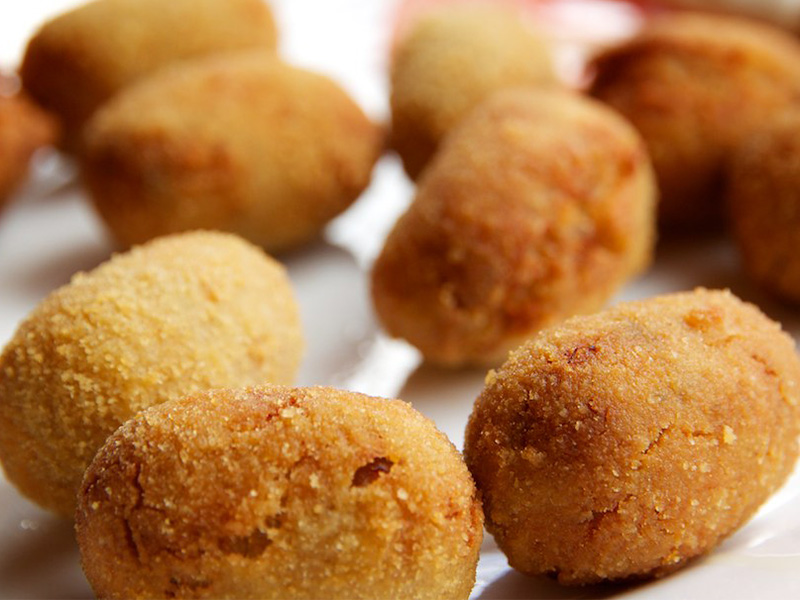
Although nothing beats Spanish home cooking, croquettes are a firm favourite in bars and restaurants throughout Spain, from Michelin star establishments to local taverns. Borrowed from French cuisine, this simple food boasts as many versions as there are palates to taste it. Cod, spinach, chicken, wild mushrooms, squid in its ink, etc. the list is endless. However, for us, there’s nothing like a great ham croquette.
Just like its recipe (or at least the version that we cook nowadays), its name is originally French. It comes from the French verb ‘croquer’, meaning to crunch and one secret to a good croquette is that it has to be crunchy.
Legend says that the first reference to croquettes dates back to 1817, when the famous chef Antonin Carême wished to surprise the Regent of England and the Archduke of Russia at the court of Louis XIV. A lot of water has passed under the bridge since that first recipe, leading to a whole range of flavours, shapes and sizes. However, there are many tricks, secrets, recommendations or whatever you want to call them that are common to any type of croquette you are cooking.
Forget leftovers: top quality ingredients only
Croquettes are often thought of as a dish made out of leftovers, be it stock, roast chicken or fish. However, to make good ham croquettes, our recommendation is to use a quality product.
Remember that the main ingredient should stand out so it’s best not to scrimp on the raw material. Even more so in the case of ham, as if we use one that was salted ‘raw’, imagine what it would be like when heated and dehydrated: pure salt.
Like a fine ham, the secret is patience
Like so many other things in life, we advocate more haste less speed. The secret to making croquette dough is simply patience.
The most usual base is bechamel, although some people prefer a velouté. The difference is that, although both are based on a roux sauce (a mixture of butter and flour), the former is made with milk and the latter with stock or fumet. We’d recommend a bechamel sauce made with milk previously infused with the ham.
Whatever you use, it is not enough to cook the dough for 5 minutes. To make a good bechamel, the first thing you do is brown the flour well with the butter, and add the flavoured milk little by little, preferably hot to avoid any lumps as it comes into contact with the hot roux. Stir constantly with a whisk until the dough lifts off the frying plan perfectly, this might easily take 20 or 30 minutes to ensure it is properly cooked. As we said: patience is the secret.
Don’t scrimp on the ham!
If we boil the milk for our bechamel with the ham, we will already have an intense flavour when we bite into the croquette but…. please, add plenty of ham! Nothing makes us fume more than a croquette that is just breaded bechamel. It is important to seek balance between the dough and the main ingredient, but essential to find ham in every mouthful.
This can be extrapolated to any type of croquette, but unfortunately, it happens all too often with the ham version. Perhaps this is because some people continue to consider it an expensive product, although it is enough to add a few chunks from the areas stuck to the bone, the bits that are difficult to slice to look presentable on the plate, and this helps us to get the most out of a piece.
It’s called a croquette for a reason
As we mentioned above, the word croquette comes from the French word ‘croquer’ meaning to crunch. Once we have made our dough, and after cooling it (preferably for 24 hours), we are then ready to shape our creations. Although they are usually oval, they can be cylindrical (generally made in a roll with a forcing bag), round or even square. Shape and the size might be subjective, but the breading isn’t.
Without playing down the filling, breading must play its role to hold its shape, but also enhance the contrast between crunchy and creamy. Consequently, there are many schools of thought. Some people use thick breadcrumbs and others prefer a fine crumb. Some only use egg and bread; others cover them in flour beforehand.
No matter how you do it, the main thing is how you fry them. Preferably in olive oil, which should be clean and at a constant temperature between 175 and 180° C. To do this, as for the dough, it is important to be patient and only put 3 or 4 croquettes in the pan at one time so that the oil temperature does not drop. Leave them properly submerged in the oil until golden, the result will doubtlessly be a wonderful ham croquette, worthy of real Spanish home cooking. Enjoy!


